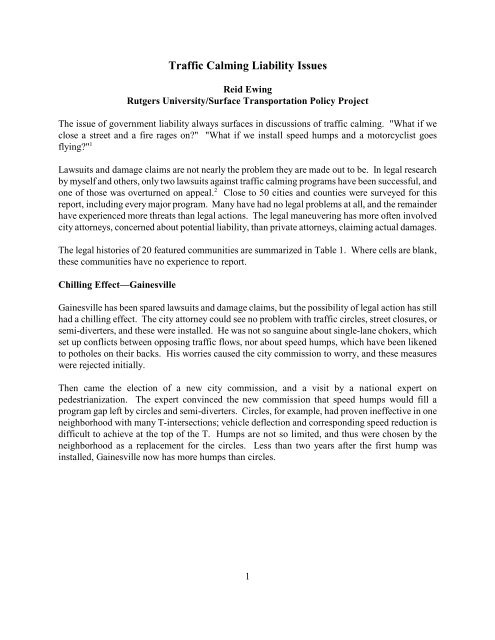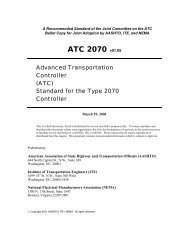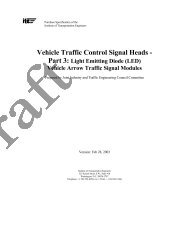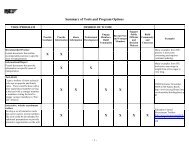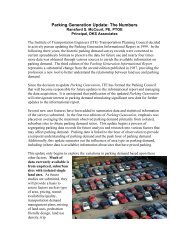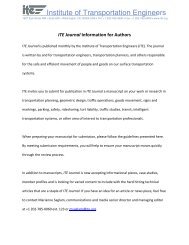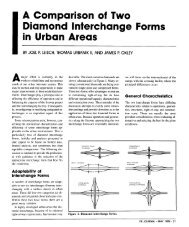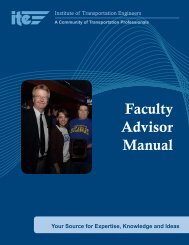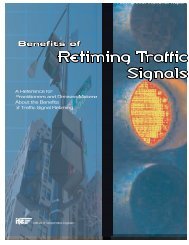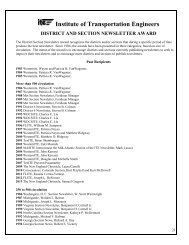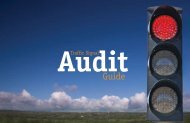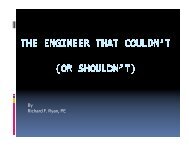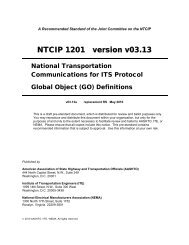Traffic Calming Liability Issues - Institute of Transportation Engineers
Traffic Calming Liability Issues - Institute of Transportation Engineers
Traffic Calming Liability Issues - Institute of Transportation Engineers
You also want an ePaper? Increase the reach of your titles
YUMPU automatically turns print PDFs into web optimized ePapers that Google loves.
<strong>Traffic</strong> <strong>Calming</strong> <strong>Liability</strong> <strong>Issues</strong><br />
Reid Ewing<br />
Rutgers University/Surface <strong>Transportation</strong> Policy Project<br />
The issue <strong>of</strong> government liability always surfaces in discussions <strong>of</strong> traffic calming. "What if we<br />
close a street and a fire rages on?" "What if we install speed humps and a motorcyclist goes<br />
flying?" 1<br />
Lawsuits and damage claims are not nearly the problem they are made out to be. In legal research<br />
by myself and others, only two lawsuits against traffic calming programs have been successful, and<br />
one <strong>of</strong> those was overturned on appeal. 2 Close to 50 cities and counties were surveyed for this<br />
report, including every major program. Many have had no legal problems at all, and the remainder<br />
have experienced more threats than legal actions. The legal maneuvering has more <strong>of</strong>ten involved<br />
city attorneys, concerned about potential liability, than private attorneys, claiming actual damages.<br />
The legal histories <strong>of</strong> 20 featured communities are summarized in Table 1. Where cells are blank,<br />
these communities have no experience to report.<br />
Chilling Effect—Gainesville<br />
Gainesville has been spared lawsuits and damage claims, but the possibility <strong>of</strong> legal action has still<br />
had a chilling effect. The city attorney could see no problem with traffic circles, street closures, or<br />
semi-diverters, and these were installed. He was not so sanguine about single-lane chokers, which<br />
set up conflicts between opposing traffic flows, nor about speed humps, which have been likened<br />
to potholes on their backs. His worries caused the city commission to worry, and these measures<br />
were rejected initially.<br />
Then came the election <strong>of</strong> a new city commission, and a visit by a national expert on<br />
pedestrianization. The expert convinced the new commission that speed humps would fill a<br />
program gap left by circles and semi-diverters. Circles, for example, had proven ineffective in one<br />
neighborhood with many T-intersections; vehicle deflection and corresponding speed reduction is<br />
difficult to achieve at the top <strong>of</strong> the T. Humps are not so limited, and thus were chosen by the<br />
neighborhood as a replacement for the circles. Less than two years after the first hump was<br />
installed, Gainesville now has more humps than circles.<br />
1
Ineffective <strong>Traffic</strong> Circle<br />
(Gainesville, FL)<br />
Speed Hump as Replacement<br />
(Gainesville, FL)<br />
Table 1<br />
Legal Challenges in Featured Communities<br />
Austin<br />
Bellevue<br />
Berkeley<br />
Boulder<br />
Charlotte<br />
Dayton<br />
Eugene<br />
Ft. Lauderdale<br />
Legal Threats and Concerns Lawsuits Damage Claims<br />
two threats <strong>of</strong> litigation, one from a<br />
local resident over undercarriage<br />
damage sustained on a hump and<br />
the other from a commuter<br />
complaining <strong>of</strong> humps on a<br />
through-street<br />
two voter initiatives to rescind<br />
citywide traffic management plan<br />
failed<br />
concerns about bicyclists about<br />
being "squeezed" at traffic circles<br />
potential liability with unwarranted<br />
4-way stops<br />
threats <strong>of</strong> litigation over street<br />
closures<br />
lawsuit challenging use <strong>of</strong> traffic<br />
diverters -- successful but<br />
decision rendered moot when<br />
California legislature excluded<br />
diverters from state regulation<br />
lawsuit by motorist injured at<br />
temporary circle -- dropped<br />
lawsuit by pedestrian claiming<br />
that raised crosswalk and<br />
narrowing should have been<br />
coupled with pedestrian signal –<br />
pending<br />
lawsuit by property owner over<br />
street closure limiting access --<br />
city excused from suit<br />
claim by motorist who<br />
bottomed out on hump at high<br />
speed -- denied<br />
15 damage claims -- denied<br />
only claim passed on to<br />
Oregon Department <strong>of</strong><br />
<strong>Transportation</strong><br />
several claims over minor<br />
damage at choker on one highvolume<br />
collector street -- paid<br />
2
Gainesville<br />
opposition from city attorney to<br />
one-lane narrowings and speed<br />
humps -- humps installed anyway<br />
after city council reversed earlier<br />
position<br />
Gwinnett<br />
County<br />
Howard<br />
County<br />
claim by motorist who<br />
bottomed out on raised<br />
intersection -- dropped<br />
Montgomery<br />
County<br />
petition drive to ban speed humps<br />
unsuccessful<br />
lawsuit by disabled veteran<br />
alleging that speed humps violate<br />
Americans with Disabilities Act --<br />
suit dismissed because humps do<br />
not deny "meaningful access"<br />
two damage claims paid, one<br />
over improperly applied hump<br />
markings and the other over an<br />
injury sustained on a hump<br />
Phoenix<br />
concern about the legality <strong>of</strong><br />
humps on collectors -- litigation<br />
threatened by cut-through traffic on<br />
local streets<br />
Portland<br />
lawsuit by family <strong>of</strong> fatal crash<br />
victim alleging that city had not<br />
done enough to calm traffic -- suit<br />
dismissed but under appeal<br />
many claims rejected as<br />
frivolous -- one claim paid<br />
when contractor pulled<br />
advisory sign too soon on a<br />
traffic circle<br />
San Diego<br />
two claims associated with<br />
damage from humps -- one<br />
paid<br />
San Jose<br />
lawsuit by bicyclist who struck<br />
debris from damaged choker --<br />
suit dismissed because city<br />
maintenance program had no time<br />
to respond<br />
claim by motorist hung up on<br />
choker after illegal maneuver -<br />
- denied<br />
Sarasota<br />
lawsuit challenging humps as<br />
unaauthorized traffic control<br />
devices – city lost but decision<br />
reversed on appeal<br />
claim by motorcyclist injured<br />
on hump under construction --<br />
denied<br />
Seattle<br />
many threats <strong>of</strong> litigation over the<br />
years, <strong>of</strong>ten for not doing enough<br />
to calm traffic<br />
about two claims filed per year<br />
-- only three small claims paid<br />
over almost 30 years -- two<br />
based on inadequate signage<br />
and one on a poorly designed<br />
speed hump<br />
Tallahassee<br />
resident demanded written<br />
acknowledgment <strong>of</strong> city’s<br />
responsibility for humps in front <strong>of</strong><br />
resident's home<br />
West Palm<br />
Beach<br />
3
Minimizing <strong>Liability</strong><br />
<strong>Transportation</strong> pr<strong>of</strong>essionals are accustomed to working with guidance documents. The American<br />
Association <strong>of</strong> State Highway and <strong>Transportation</strong> Officials’ A Policy on Geometric Design <strong>of</strong><br />
Highways and Streets and Federal Highway Administration’s Manual on Uniform <strong>Traffic</strong> Control<br />
Devices (MUTCD) have been characterized as the pr<strong>of</strong>ession’s "bibles." These universally accepted<br />
manuals take much <strong>of</strong> the risk out <strong>of</strong> roadway design. Follow these manuals and you, the<br />
transportation pr<strong>of</strong>essional, are unlikely to end up on the losing end <strong>of</strong> a lawsuit.<br />
<strong>Traffic</strong> calming is another matter due to the lack <strong>of</strong> any comparable guidance document. <strong>Traffic</strong><br />
calming measures are not simple geometric features <strong>of</strong> streets, nor are they traffic control devices in<br />
the MUTCD sense (see below). Thus, the standard guidance documents are <strong>of</strong> limited use.<br />
The Europeans, British, Australians, and Canadians have design manuals, rules, and/or regulations<br />
governing traffic calming. 3 But in the U.S., there is no national design manual and may never be.<br />
There seems to be as much support among traffic managers for flexibility as for standardization.<br />
In the absence <strong>of</strong> standards, what is to immunize traffic calming programs against legal challenges?<br />
The answer is: a rational planning and implementation process. A rational approach is important<br />
in tort liability and substantive due process cases. Government’s exercise <strong>of</strong> police powers, including<br />
the power to control traffic, must not be arbitrary, capricious, or unreasonable.<br />
Program features that contribute to reasonableness include:<br />
Ä documentation <strong>of</strong> traffic problems via speed measurements, traffic counts, and/or other studies;<br />
Ä consideration <strong>of</strong> alternative traffic calming measures and selection <strong>of</strong> one capable <strong>of</strong> solving<br />
documented problems;<br />
Ä installation <strong>of</strong> measures on a trial basis subject to follow-up performance evaluation; and<br />
Ä follow-up evaluation <strong>of</strong> impacts to check that measures have performed as intended. 4<br />
<strong>Traffic</strong> calming programs structured as popularity contests, relying exclusively on neighborhood<br />
petitions and financial antes to decide what gets build, are inviting litigation. Likewise, programs<br />
relying on casual observation <strong>of</strong> traffic conditions, ad hoc contacts with neighbors, and intuitive<br />
judgments, are at legal risk.<br />
4
&LWL]HQÃ<br />
UHTXHVWÃ<br />
Is traffic<br />
calming<br />
needed? Staff<br />
study<br />
3KDVHÃ2QHÃ<br />
WHVWHGÃIRUÃÃ<br />
PRQWKVÃ<br />
Case Law -- Legal Authority<br />
While members <strong>of</strong> the public have a right to use public highways, this right is subject to the power<br />
<strong>of</strong> local governments to impose reasonable restrictions on their use for the protection <strong>of</strong> the public.<br />
In some states, the right <strong>of</strong> a local government to interfere with the free flow <strong>of</strong> traffic requires<br />
express statutory authority. These states have preempted the regulation and control <strong>of</strong> traffic on all<br />
highways and streets, including those under the jurisdiction <strong>of</strong> local governments. In other states,<br />
local governments’ general authority to construct and maintain streets has been interpreted by courts<br />
as providing ample authority for street closures and similar actions.<br />
Challenge to Diverters—Berkeley<br />
In California, the state has preempted the entire field <strong>of</strong> traffic control. A locality has no right to<br />
interfere with the free flow <strong>of</strong> traffic unless expressly authorized by state statute. This fact led to the<br />
best known legal challenge to traffic calming, Rumford v. City <strong>of</strong> Berkeley, 31 Cal.3d 545, 645 P.2d<br />
124 (1982). At the time <strong>of</strong> the lawsuit, Berkeley had placed large concrete movable bollards on more<br />
than 40 streets to create full closures, diagonal diverters, and half closures. The barriers had proven<br />
effective in reducing traffic volumes and collisions. Twice, the electorate had voted down ballot<br />
measures to remove the barriers.<br />
The California Supreme Court ruled that the diverters and half closures were traffic control devices<br />
not authorized by state law. They were not complete closures, which had been authorized under<br />
certain circumstances, nor signs or symbols, which had also been authorized. They were not<br />
permanent changes in curb location or median installations, which had been authorized as well.<br />
Hence the diverters and partial closures were declared illegal.<br />
Dissenting judges noted the absurdity <strong>of</strong> banning measures which had the same effect as mandatory<br />
turn signs, but were not as easily disobeyed...<br />
also <strong>of</strong> banning measures which had the same<br />
effect as permanent changes in the curb line, but<br />
were movable as conditions changed.<br />
Ultimately, the matter was settled by the state<br />
legislature, which gave local governments the<br />
authority to block entry to or exit from any street<br />
by means <strong>of</strong> islands, curbs, traffic barriers, or<br />
roadway design features. The legislature also<br />
exempted traffic calming measures from the<br />
definition <strong>of</strong> <strong>of</strong>ficial traffic control device and<br />
hence from state regulation. The statutory<br />
exclusion, expanded recently, applies to<br />
“islands, curbs, traffic barriers, speed humps,<br />
speed bumps, or roadway design features.”<br />
“Temporary” Diverter Challenged in Court<br />
(Berkeley, CA)<br />
6
Challenge to Humps and Tables—Sarasota<br />
As traffic calming has become commonplace, arguments over the authority to install traffic calming<br />
measures have subsided. Thus, it came as a surprise when Sarasota was sued recently on essentially<br />
the same grounds as was Berkeley 15 years earlier. Like California, the state <strong>of</strong> Florida has<br />
preempted the field <strong>of</strong> traffic control. Cities and counties have power to regulate traffic only by<br />
means <strong>of</strong> <strong>of</strong>ficial traffic control devices, which must conform to the specifications <strong>of</strong> the Florida<br />
Department <strong>of</strong> <strong>Transportation</strong> (FDOT). FDOT has adopted the MUTCD as its <strong>of</strong>ficial guide to<br />
traffic control devices.<br />
The plaintiffs claim: speed humps and speed tables are traffic control devices not recognized by the<br />
MUTCD and hence illegal. In a letter to the plaintiffs, the State <strong>Traffic</strong> Engineer agreed but said it<br />
was none <strong>of</strong> the state’s business. The city’s response: Sovereign immunity protects the city from<br />
such claims; speed humps and speed tables are not traffic control devices but instead traffic calming<br />
measures; and the installation <strong>of</strong> such measures falls under the city's broad home rule and police<br />
powers.<br />
In June 1998, the circuit court ruled against the city, finding that speed humps and speed tables are<br />
unauthorized traffic control devices. The city was enjoined from installing additional humps or<br />
tables, and has been ordered to remove existing humps and tables. Removal, which could have cost<br />
as much as a quarter million dollars, was stayed pending appeal.<br />
On appeal, the decision was reversed on a<br />
procedural ground. The plaintiffs lacked<br />
standing under traffic control statute and state<br />
law generally. Under this statute, only FDOT<br />
has the power to compel removal <strong>of</strong> an illegal<br />
traffic control device. And FDOT had failed to<br />
take such an action. Under state law generally,<br />
plaintiffs have a cause <strong>of</strong> action only if they<br />
suffer special damages distinct from the rest <strong>of</strong><br />
the community. And these plaintiffs were no<br />
more affected by the traffic calming measures<br />
than were drivers generally.<br />
Clearly, until traffic calming is authorized in<br />
state law and/or traffic calming is clearly<br />
distinguished from traffic control in state law,<br />
there is the possibility <strong>of</strong> further litigation<br />
along these lines in Florida and elsewhere.<br />
Speed Table Challenged as an Illegal <strong>Traffic</strong><br />
Control Device<br />
(Sarasota)<br />
7
Note on the MUTCD<br />
On the first page <strong>of</strong> the MUTCD, traffic control devices are defined by purpose and use statements: 5<br />
The purpose <strong>of</strong> traffic control devices and warrants for their use is to help insure highway<br />
safety by providing for the orderly and predictable movement <strong>of</strong> all traffic, motorized and<br />
non-motorized, throughout the national highway system, and to provide such guidance and<br />
warnings as are needed to insure the safe and informed operation <strong>of</strong> individual elements <strong>of</strong><br />
the traffic stream.<br />
<strong>Traffic</strong> control devices are used to direct and assist vehicle operators in the guidance and<br />
navigation tasks required to traverse safely any facility open to the public.<br />
Consistent with this emphasis on guidance and warning, the MUTCD deals almost exclusively with<br />
signs, markings, and signals. The only physical features <strong>of</strong> the roadway to be addressed are islands,<br />
specifically, pedestrian refuge islands, traffic divisional islands, and traffic channelizing islands.<br />
Because islands fall outside the scope <strong>of</strong> traffic control, the next MUTCD edition will deal only with<br />
the delineation, signing, and marking <strong>of</strong> islands, not with their physical characteristics.<br />
By contrast to traffic control, traffic calming involves changes in street alignment, installation <strong>of</strong><br />
barriers, and other physical measures to reduce traffic speeds and/or cut-through traffic volumes.<br />
<strong>Traffic</strong> calming measures would appear to be quite distinct from traffic control devices.<br />
Case Law -- Tort <strong>Liability</strong><br />
Government has a legal duty to exercise ordinary care for the safety <strong>of</strong> motorists who are themselves<br />
exercising ordinary care. If this duty is breached, and someone is injured, it can lead to a tort claim<br />
for government negligence.<br />
In order to establish tort liability, the following elements must be proven:<br />
(1) The defendant must owe a legal duty to the injured plaintiff;<br />
(2) There must be a breach <strong>of</strong> the duty through the failure to perform or the negligent<br />
performance <strong>of</strong> that duty;<br />
(3) The breach <strong>of</strong> duty must be a proximate cause <strong>of</strong> the accident; and<br />
(4) The plaintiff must have suffered damages as a result <strong>of</strong> the accident.<br />
In both case and statutory law, the distinction is made between discretionary functions which are<br />
generally immune from tort claims and ministerial functions which are not. Discretionary functions<br />
involve a choice among valid alternatives. Ministerial functions involve operational decisions that<br />
leave minimal leeway for personal judgment.<br />
The decision to spend public funds on traffic calming, or to install one set <strong>of</strong> measures versus<br />
8
another, or to design measures for one speed versus another, is discretionary. The duty to warn<br />
motorists <strong>of</strong> traffic calming measures that require slowing down, or to maintain measures in a safe<br />
condition, or to construct measures per design specifications, is ministerial.<br />
Discretion in the Choice <strong>of</strong> Measures—Portland<br />
Under sovereign immunity, courts will not second-guess discretionary decisions <strong>of</strong> public <strong>of</strong>ficials<br />
if there is any reasonable basis for them. 6 A recent case out <strong>of</strong> Portland is most germane. A young<br />
woman died in a collision on a street that was traffic calmed farther down, but not at the accident<br />
location. While complicated by drinking and reckless driving, and by the question <strong>of</strong> whether the<br />
exact measures approved by the city council had been installed, the central issue was whether the city<br />
had done enough to prevent collisions <strong>of</strong> this type. The plaintiffs claimed that a diverter should have<br />
been used on this particular street to prevent the teenage practice <strong>of</strong> "hill jumping." Instead,<br />
following its standard planning process, the city had installed a traffic island and a couple <strong>of</strong> traffic<br />
circles many years before. The neighborhood had specifically considered and rejected a diverter.<br />
A jury found in favor <strong>of</strong> the city. The verdict is presently under appeal.<br />
One Inherently Dangerous Device—Speed Bumps<br />
There is an exception to government discretion in the choice <strong>of</strong> traffic calming measures. One<br />
physical measure has been found by some courts to be patently unsafe when applied to public streets.<br />
It is the speed bump, as opposed to the longer speed hump. 7 Speed bumps are abrupt features that<br />
rise and fall 3 to 4 inches over a span <strong>of</strong> 1 to 3 feet. Bumps have comfortable crossing speeds <strong>of</strong> 5<br />
mph or less, which relegates them to parking lots and private driveways as opposed to public<br />
roadways with their higher posted speed limits. 8 In Vickburg v. Harrellton, a landmark case , the<br />
Mississippi Supreme Court ruled that speed bumps constituted an inherent danger to motorists. The<br />
Connecticut courts reached the same conclusion, though with a different reason for declaring them<br />
a public nuisance: their low design speeds could so delay emergency vehicles as to cause serious<br />
injury or loss <strong>of</strong> life. 9 While an occasional speed bump is still found on a public road, jurisdictions<br />
using this measure are asking for legal<br />
problems.<br />
Bump Pr<strong>of</strong>ile vs. Hump Pr<strong>of</strong>ile<br />
9
Adequate Response to a Safety Hazard—San Jose<br />
If government creates a hazardous condition, or<br />
knows <strong>of</strong> one on public property, it has a<br />
ministerial duty to either remove the hazard or<br />
warn <strong>of</strong> it. 10 Designing a road with a sharp<br />
curve does not create liability in itself. "If,<br />
however, the governmental entity knows when<br />
it creates a curve that vehicles cannot safely<br />
negotiate the curve at speeds <strong>of</strong> more than<br />
twenty-five miles per hour, such entity must<br />
take steps to warn the public <strong>of</strong> the danger." 11<br />
<strong>Traffic</strong> calming generally improves traffic<br />
safety. Favorable impacts are documented in<br />
Chapter 5, <strong>Traffic</strong> <strong>Calming</strong> State-<strong>of</strong>-the- Tight Geometrics that Led to One Accident<br />
Practice. 12 Yet, unless measures are wellmarked<br />
and well-signed, they can catch<br />
(San Jose)<br />
motorists by surprise. Likewise, unless they<br />
are well-maintained, measures can deteriorate under use to the point <strong>of</strong> creating a hazard.<br />
Diverters and chokers in one San Jose neighborhood have such tight geometrics that an occasional<br />
large vehicle strikes them while making a turn. A bicyclist was injured when she ran over debris<br />
left from one such incident. She sued. While the city had a ministerial duty to clean up the debris,<br />
it was absolved <strong>of</strong> responsibility for the bicycle accident because it happened so soon after the truck<br />
incident. The city’s maintenance program was found to be adequate overall.<br />
Case Law -- Loss <strong>of</strong> Access<br />
The takings clauses <strong>of</strong> the federal constitution and that <strong>of</strong> most states require that private property<br />
not be taken without just compensation. A restriction does not effect a taking if it "substantially<br />
advance[s] legitimate state interests" and does not "den[y] an owner economically viable use <strong>of</strong> his<br />
land." Typically, in takings litigation the courts engage in a case-by-case inquiry in which the<br />
following factors are assessed:<br />
(1) the economic impact <strong>of</strong> the regulation on the claimant;<br />
(2) the extent to which the regulation has interfered with distinct investment-backed<br />
expectations; and<br />
(3) the character <strong>of</strong> the governmental action.<br />
Businesses, in particular, rely on good access to remain viable. Thus, street closures and other severe<br />
access limitations can generate takings claims against government.<br />
10
Commercial Access—Seattle<br />
There have been many lawsuits occasioned<br />
by access management projects on major<br />
roads. The installation <strong>of</strong> medians,<br />
creation <strong>of</strong> service roads, construction <strong>of</strong><br />
overpasses, and the like <strong>of</strong>ten hurt<br />
businesses at the same time they improve<br />
traffic flow. These are not traffic calming<br />
cases per se, but the same legal principles<br />
apply. A taking <strong>of</strong> property occurs, and<br />
businesses are entitled to just<br />
compensation, if their right <strong>of</strong> access is<br />
"substantially diminished." Generally, loss<br />
<strong>of</strong> the most convenient access is not<br />
compensable where suitable alternatives<br />
exist. Nor is a government action that<br />
diminishes traffic flow past a business.<br />
Only if direct access to an abutting<br />
highway is cut <strong>of</strong>f entirely, and no good<br />
alternative route exists, is compensation<br />
required. 13<br />
Street Closure that Prompted<br />
Unsuccessful Lawsuit<br />
(Seattle)<br />
The only related traffic calming case is Mackie v. Seattle, 19 Wn.App. 464 576 Pacific Reporter 2nd.<br />
414 (1978). Seattle was sued over the inconvenience and potential loss <strong>of</strong> sales caused by the closure<br />
<strong>of</strong> a through-street. While the street provided the most direct route to the business, the court found<br />
no ground for compensation since access had not been completely denied.<br />
Residential Access—Memphis, TN<br />
There have been lawsuits involving the closure <strong>of</strong> neighborhood streets to outsiders through gating.<br />
If the streets are public to begin with, this kind <strong>of</strong> closure is discriminatory and illegal. Not so a<br />
closure or access limitation that leaves a street open to everyone, but makes it more difficult for<br />
everyone to get in and out. This kind <strong>of</strong> closure -- in response to traffic, crime, or some other threat<br />
to public welfare -- is a legitimate use <strong>of</strong> the police power, constrained only by requirements <strong>of</strong> equal<br />
protection and due process.<br />
In Memphis v. Greene, 451 U.S. 100 (1981), the U.S. Supreme Court upheld a street closure against<br />
a civil rights challenge. A barrier was erected at the dividing line between black and white<br />
neighborhoods. The court ruled the interests <strong>of</strong> tranquility and safety from traffic "legitimate" and<br />
sufficient to justify "an adverse impact on motorists who are somewhat inconvenienced by the street<br />
closing." The only injury suffered by black or white residents was that one street rather than another<br />
would have to be used for certain trips.<br />
11
Access for the Disabled—Montgomery County<br />
In a different kind <strong>of</strong> access-related challenge,<br />
Slager v. Montgomery County, a disabled<br />
veteran with a spinal injury sued the county to<br />
prevent the installation <strong>of</strong> speed humps on his<br />
street. His suit was filed under the Americans<br />
with Disabilities Act <strong>of</strong> 1990. The veteran<br />
alleged that the proliferation <strong>of</strong> humps<br />
interferred with his use <strong>of</strong> county streets due to<br />
the pain they caused him; that he spent an extra<br />
20 minutes commuting to work just to avoid<br />
them; and that he would have no way <strong>of</strong><br />
avoiding them if they were placed on his own<br />
residential street. The court dismissed his<br />
lawsuit, concluding that while the humps<br />
presented the man with difficulty, they did not<br />
"totally bar his use <strong>of</strong> the roads" nor leave him<br />
without "meaningful access."<br />
One <strong>of</strong> More Than 1,100 Speed Humps<br />
(Montgomery County)<br />
Case Law -- Failure to Act<br />
This discussion ends with a new cause <strong>of</strong> legal action, alleged government negligence for failure to<br />
calm traffic on streets with excessive volumes or speeds. Seattle reports more threats <strong>of</strong> litigation<br />
for failure to act than for acting.<br />
As already noted, the courts will not interfere with discretionary functions <strong>of</strong> other branches <strong>of</strong><br />
government. Perhaps the most important discretionary function is deciding where tax dollars should<br />
be spent. <strong>Traffic</strong> calming is just one <strong>of</strong> many competing local government priorities, and within the<br />
traffic calming budget, a particular project is just one <strong>of</strong> many competing for funds. Even where<br />
a need for traffic calming can be clearly demonstrated, private parties have no direct remedy to abate<br />
public nuisances. <strong>Traffic</strong> is a public, not a private, nuisance.<br />
Public Nuisance—Sacramento Case<br />
In Friends <strong>of</strong> H Street v. City <strong>of</strong> Sacramento, 24 Cal.Rptr.2nd 607 (Cal.App. 3 Dist. 1993), residents<br />
filed a nuisance complaint to force the city to do something about freeway-level volumes and<br />
excessive speeds on their street. The relief sought was the designation <strong>of</strong> their street as a local one,<br />
with operational changes to bring volumes down to the street’s "environmental capacity" (that is,<br />
down to the maximum volume consistent with a good residential environment). The court ruled<br />
against the residents, holding that the routing <strong>of</strong> traffic is at the discretion <strong>of</strong> the city council, that<br />
the rerouting <strong>of</strong> traffic in this case would hurt other streets, and that the city council could not please<br />
12
everyone. As the court saw it: "... loss <strong>of</strong> peace<br />
and quiet is a fact <strong>of</strong> life which must be endured<br />
by all who live in the vicinity <strong>of</strong> freeways,<br />
highways, and city streets."<br />
Damage Claims<br />
From Table 1, it is apparent that damage claims<br />
filed with cities and counties are much more<br />
common than lawsuits filed with courts (as they<br />
must be, since state laws require that<br />
administrative remedies be exhausted before<br />
lawsuits are filed). But damage claims are still<br />
relatively rare, and the number claims paid is<br />
minuscule. Given the hundreds <strong>of</strong> traffic calming<br />
measures in place for many years in featured<br />
communities, these numbers are surprising small.<br />
H Street <strong>Traffic</strong><br />
(Sacramento)<br />
Having the longest running program, and the most measures in place, Seattle has the most experience<br />
with damage claims. 14 About two claims are filed on average per year. Yet, over a 15 year-period,<br />
only three claims have been paid. This is nothing compared to the number <strong>of</strong> claims filed and paid<br />
in connection with, for example, potholes.<br />
Two <strong>of</strong> the three claims paid involved signage. Government’s ministerial duty to warn motorists <strong>of</strong><br />
hazards was breached in both cases. In one case, an object marker sign on a traffic circle had been<br />
knocked down and was not replaced for lack <strong>of</strong><br />
a spare in inventory. $600 in damage was done<br />
to the undercarriage <strong>of</strong> an automobile when it ran<br />
onto the center island. In another case,<br />
barricades were removed prematurely from a<br />
circle under construction. An automobile had to<br />
be realigned, at a cost <strong>of</strong> $30, after it ran over the<br />
curb and into the center island as yet unfilled<br />
with dirt.<br />
The third claim paid by Seattle involved a poorly<br />
constructed speed hump. It was back in the early<br />
1980s, before hump designs had been standardized in the U.S. A hump only slightly longer than a<br />
speed bump, and about 6 inches high, took the<br />
bottom out <strong>of</strong> an automobile. Damages were<br />
paid, and the <strong>of</strong>fending hump was removed.<br />
These experiences, and lawsuits and damage<br />
"Foreign Objects" in a Choker Island<br />
(Seattle)<br />
13
claims arising from street design and maintenance generally, have made Seattle hyper-sensitive to<br />
the potential for liability in its traffic calming program. Going out with the manager <strong>of</strong> the traffic<br />
calming program to photograph traffic calming measures, we came across a choker "landscaped"<br />
with some medium-sized rocks. The rocks, placed there by neighbors responsible for landscape<br />
maintenance, were apparently intended to protect the landscaping from errant vehicles. Aware <strong>of</strong><br />
a large damage award over rocks in a highway median, the manager declared that the "foreign<br />
objects" would be removed from the island post haste, and they were. Wherever landscape<br />
maintenance is left to neighbors, this kind <strong>of</strong> overzealous protection <strong>of</strong> landscaping may result.<br />
Two other featured communities have had to pay multiple claims. Ft. Lauderdale’s claims have<br />
involved wheel damage sustained by cars striking a choker on a high-volume collector street. This<br />
choker poses a particular threat because it has a vertical monument on one side <strong>of</strong> the street and, until<br />
recently, nothing on the other side (due to a fronting property owner’s objection). The number <strong>of</strong><br />
claims and apparent design flaw caused the city’s risk manager to take a public stand against the<br />
installation. The city traffic engineer responded by planting a tree on the problem side, giving it<br />
some vertical definition as well.<br />
Montgomery County has paid two claims involving speed humps. In one case, the driver <strong>of</strong> a<br />
community college van went over a hump at a speed acknowledged to be too high, and a student was<br />
injured. Though not at fault, the county agreed to pay $2,500 in medical expenses to avoid the<br />
expense <strong>of</strong> litigation. In the other case, hump markings came <strong>of</strong>f on the undercarriage <strong>of</strong> a car that<br />
bottomed out traveling too fast. Because the hump markings had been improperly applied, the<br />
county assumed liability for $300 in damages associated with removal <strong>of</strong> tape and glue.<br />
Problem Choker Before and After<br />
(Ft. Lauderdale, FL)<br />
14
1. A survey <strong>of</strong> 407 urban traffic agencies found legal liability to be their greatest concern about<br />
use <strong>of</strong> speed humps. Yet, among the dozens <strong>of</strong> agencies using speed humps at that time, only<br />
one had ever paid a damage claim, and this for only $2,500. ITE Technical Council Committee<br />
5B-15, "Road Bumps - Appropriate for Use on Public Streets," ITE Journal, Vol. 56, November<br />
1986, pp. 18-21.<br />
2. A review <strong>of</strong> case law conducted for the state <strong>of</strong> Washington came up with nothing except the<br />
old Berkeley case. J.P. Savage, R.D. MacDonald, and J. Ewell, A Guidebook for Residential<br />
<strong>Traffic</strong> Management, Washington Department <strong>of</strong> <strong>Transportation</strong>, Olympia, WA, 1994.<br />
3. Director General <strong>of</strong> Transport for South Australia, Residential Street Management Manual,<br />
Adelaide, 1987; Institution <strong>of</strong> Highways and <strong>Transportation</strong>, Roads and <strong>Traffic</strong> in Urban Areas,<br />
Her Majesty’s Stationary Office, London, 1987, pp. ; AUSTROADS, Guide to <strong>Traffic</strong><br />
Engineering Practice - Part 10 - Local Area <strong>Traffic</strong> Management, Sidney, 1988; Main Roads<br />
Department - Western Australia, Guidelines <strong>of</strong> Local Area <strong>Traffic</strong> Management, East Perth,<br />
1990; Committee MS/12, Manual <strong>of</strong> Uniform <strong>Traffic</strong> Control Devices - Part 13: Local Area<br />
<strong>Traffic</strong> Management, Standards Association <strong>of</strong> Australia, Sidney, 1991; J. Marstrand et al.,<br />
Urban <strong>Traffic</strong> Areas - Part 7: Speed Reducers, Vejdirektoratet - Vejregeludvalget, The<br />
Netherlands, 1991; Kent County Council, <strong>Traffic</strong> <strong>Calming</strong> - A Code <strong>of</strong> Practice, Maidstone,<br />
Great Britain, 1992; Delcan/Urban Systems, Guide to Neighbourhood <strong>Traffic</strong> <strong>Calming</strong>,<br />
<strong>Transportation</strong> Association <strong>of</strong> Canada/Canadian <strong>Institute</strong> <strong>of</strong> <strong>Transportation</strong> <strong>Engineers</strong>, 1998.<br />
4. In an early legal analysis <strong>of</strong> traffic controls, "reasonableness" in the exercise <strong>of</strong> police powers<br />
was linked to:<br />
Ä Evidence <strong>of</strong> Need for Action - Harm to Residents<br />
Ä Alternative <strong>Traffic</strong> Control Measures, Attempted or Considered<br />
Ä Relationship to an Overall <strong>Transportation</strong> Plan<br />
Ä Reasonable Access for Emergency Vehicles<br />
Ä Conduct <strong>of</strong> Public Hearings<br />
D.T. Smith and D. Appleyard, Improving the Residential Street Environment, Federal Highway<br />
Administration, Washington, D.C., 1981, pp. 132-133.<br />
5. Federal Highway Administration (FHWA), Manual on Uniform <strong>Traffic</strong> Control Devices for<br />
Streets and Highways, Washington, D.C., 1988, p.1A-1.<br />
6. A government body may be held liable only if its study <strong>of</strong> a traffic condition is plainly<br />
inadequate or there is no reasonable basis for its traffic plan. Redcross v. State <strong>of</strong> New York,<br />
660 N.Y.S.2d 211.<br />
7. The distinction between humps and bumps is elaborated on in H.S. Chadda and S.E. Cross,<br />
"Speed (Road) Bumps: <strong>Issues</strong> and Opinions," Journal <strong>of</strong> <strong>Transportation</strong> Engineering, Vol. 111,<br />
1985, pp. 410-418. Also see ITE Technical Council Task Force on Speed Humps, op. cit.; and<br />
15
Smith and Appleyard, op. cit., pp. 48-49.<br />
8. Despite their low design speeds, bumps have less overall impact at high speeds than do<br />
humps because the vehicle suspension quickly absorbs the impact <strong>of</strong> bumps before the vehicle<br />
body has time to react. Bicycles, motorcycles and other vehicles with rigid suspensions are<br />
more susceptible to damage and loss <strong>of</strong> control on bumps or humps.<br />
9. A. Davis, “Speed Bumps Enjoined in Connecticut,” ITE Journal, Vol. 50, May 1980, p. 16.<br />
10. To prevail under a theory <strong>of</strong> negligence, a citizen must demonstrate by a preponderance <strong>of</strong><br />
evidence that government breached its duty <strong>of</strong> care, and that he or she suffered damages as a<br />
result.<br />
11. Polk County v. Donna M. Safka, 675 So. 2d 615.<br />
12. R. Ewing, <strong>Traffic</strong> <strong>Calming</strong> State-<strong>of</strong>-the-Practice, <strong>Institute</strong> <strong>of</strong> <strong>Transportation</strong> <strong>Engineers</strong>,<br />
Washington, D.C., 1999.<br />
13. Representative access management cases include: City <strong>of</strong> Orlando v. Cullom, 400 So.2nd<br />
513; Paradyne Corp. v. Florida Department <strong>of</strong> <strong>Transportation</strong>, 528 So.2d 921 (Fla.App. 1988);<br />
Palm Beach County v. Tessler, 538 So.2d 846, 850 (Fla. 1989); Rubano v. Department <strong>of</strong><br />
<strong>Transportation</strong>, 656 So.2d 1264 (Fla. 1995); State Department <strong>of</strong> <strong>Transportation</strong> v. Kreider,<br />
658 So.2d 548 (Fla.App. 1995); Brumer v. Los Angeles County Metropolitan <strong>Transportation</strong><br />
Authority, 36 Cal.App.4th 1738, 43 Cal.Rptr.2d 314; and Pringle v. City <strong>of</strong> Wichita, 22<br />
Kan.App.2d 297, 917 P.2d 1351.<br />
14. For descriptions <strong>of</strong> damage claims filed against other programs, see R. Ewing and C.<br />
Kooshian, "U.S. Experience with <strong>Traffic</strong> <strong>Calming</strong>," ITE Journal, Vol. 67, August 1997, pp. 28-<br />
33.<br />
16


